Did you know carrots in containers face fewer pests like slugs and rabbits? This makes how to grow carrots in containers appealing to all gardeners. You can grow these tasty roots on your patio or balcony, no garden needed.
With the right planning, you can harvest carrots from summer to fall. Growing carrots in pots makes pest control and soil care easier. This guide will help you grow carrots in pots, making gardening fun and rewarding.
Table of Contents
Why Grow Carrots in Containers
Growing carrots in containers is a great choice for gardeners. It’s a space-saving way to grow tasty, healthy veggies at home. Even if you have a small garden or poor soil, container gardening makes it possible.
Space Efficiency
Container gardening for carrots saves space. You can put them on patios, balconies, or windowsills. It’s perfect for city living, needing just 6 inches of soil for some varieties.
But, carrots need at least 12 inches of soil to grow well. This depth helps them develop strong roots.
Pest Control
Container gardens are easier to protect from pests. Slugs and deer are less likely to get to your carrots. This keeps your plants healthy and reduces the need for chemicals.
Soil Quality Control
With container gardening, you control the soil. Using soilless potting media improves drainage and aeration. This is key for growing carrots.
Adding rich potting soil and organic amendments like bone meal boosts nutrients. This leads to healthier plants and a better harvest.
The Best Containers for Growing Carrots
Choosing the right containers is key to growing carrots successfully. It’s important to consider the material and depth for the best results.
Material Considerations
There are many materials to choose from for containers. Plastic and fiberglass are good because they last long and keep moisture in. Fabric grow bags are also great, as they let air in and keep roots cool.
But, avoid metal or untreated wood. They can make the soil too hot or dry, which is bad for carrots.
Depth Requirements
The container’s depth is critical for carrot roots. A minimum of 12 inches is needed for straight growth. This size is perfect for smaller carrot varieties, which grow well in containers.
Make sure your containers have holes for drainage. This prevents root rot and helps you get a good harvest.
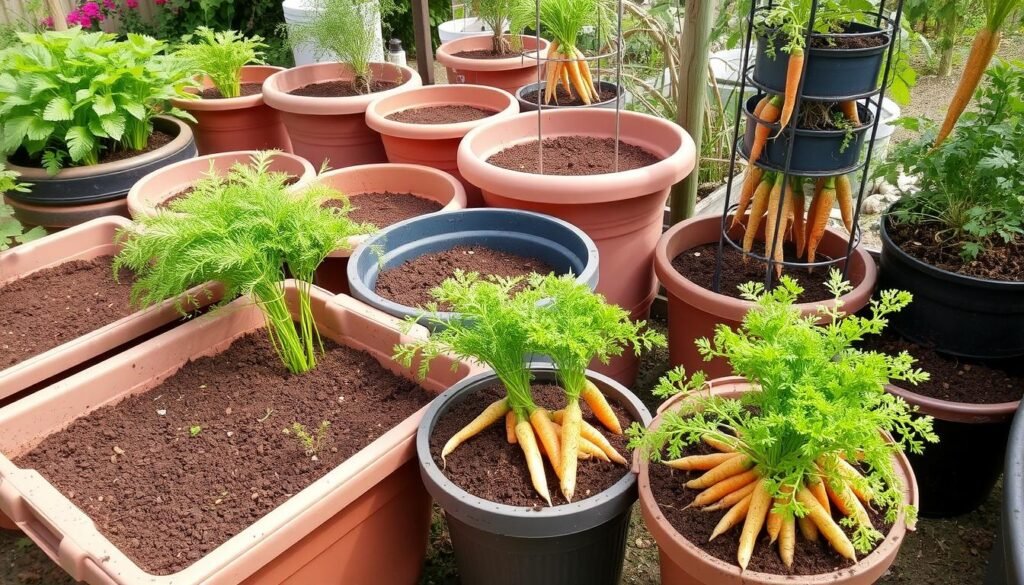
How to Grow Carrots in Containers
Starting a container garden with carrots requires picking the right variety and the right pot size. The type of carrot you choose can greatly affect your harvest. The size and shape of your container also play a big role in how well your carrots grow.
Choosing Varieties
For growing carrots in pots, pick short-rooted varieties like Parisian Market or Chantenay. These varieties do well in small spaces and give a good yield. They can take anywhere from 55 to 80 days to mature, fitting into your gardening schedule.
Container Size and Shape
The size of your container is key for carrot growth. You need at least 12 inches deep to let the roots grow. Different shapes can affect how many carrots you can grow:
| Container Shape | Dimensions | Estimated Yield |
|---|---|---|
| Round Pot | Diameter: 33cm (13″), Depth: 30cm (12″) | 30-40 carrots |
| Square Container | 32cm (13″) square, Depth: 30cm (12″) | Varies |
| Rectangular Container | Length: 55cm (22″), Width: 20cm (8″), Depth: 20cm (8″) | Higher yield |
Think about these points when planning your container garden. Bigger pots help roots grow and keep the soil moist. This can make growing carrots in pots more successful.
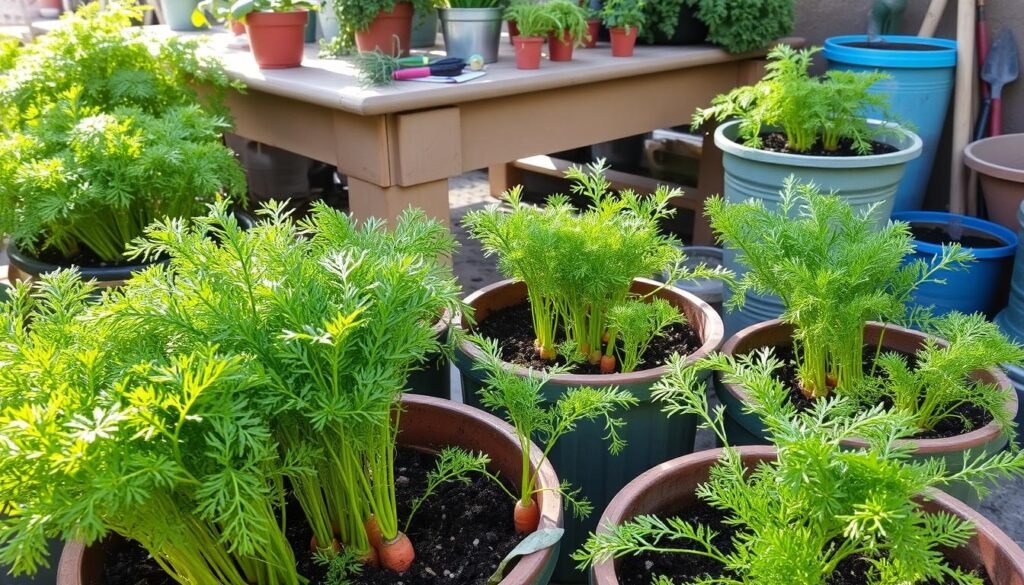
Preparing the Growing Medium
For container carrot cultivation to succeed, the right growing medium is key. You need to focus on the soil’s composition and drainage. A good mix supports healthy roots, while proper drainage prevents water problems.
Soil Composition
The best soil for carrots is a mix that’s airy and full of nutrients. A sandy or loamy mix with a pH of 6 to 7.5 is ideal. You can use a vegetable gardening soil mix or a blend of compost, peat moss, and vermiculite. This mix ensures the soil is loose, helping carrots grow straight.
Drainage Importance
Drainage is vital in container gardens to prevent waterlogged soil. Make sure your container has enough holes for water to drain. Drilling holes in the bottom helps excess water flow out. This keeps the soil healthy for your carrots.
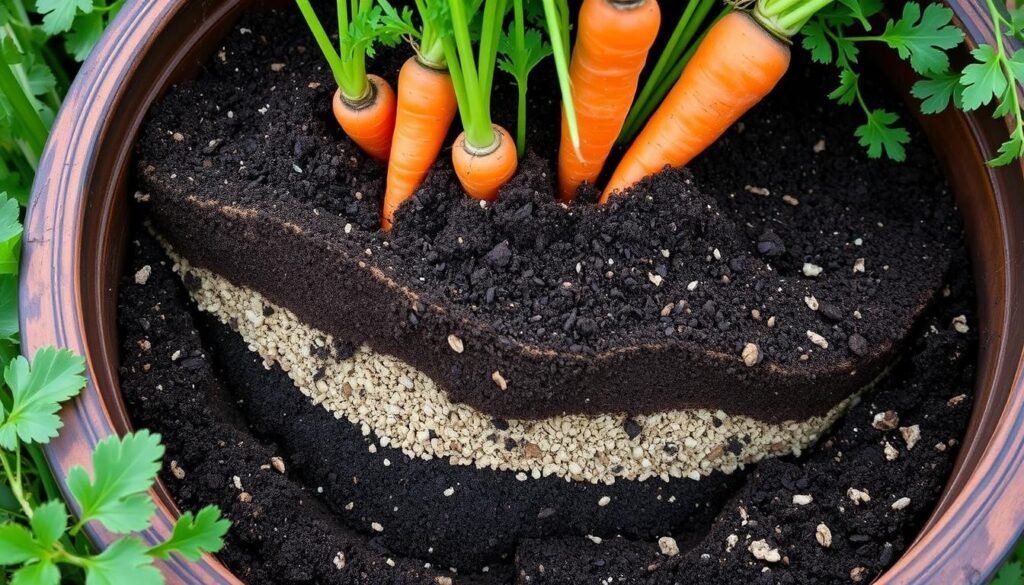
| Aspect | Recommendation |
|---|---|
| Soil Type | Sandy or Loamy |
| Ideal Soil pH | 6.0 – 7.5 |
| Recommended Mix | 2/3 Potting Mix, 1/3 Compost |
| Container Depth | At least 12 inches |
| Drainage Strategy | Drill holes in container bottom |
Spending time on the growing medium’s preparation is worth it. The right soil and drainage ensure your carrots thrive in containers.
Planting Carrots in Containers
Planting carrots in containers needs the right techniques for them to grow well. Knowing how deep and far apart to plant the seeds is key. This part will guide you on how to start your carrot seeds right.
Seed Depth and Spacing
Plant carrot seeds about ¼ inch deep. Make sure to leave enough space between them. They should be at least 1 inch apart but no more than 3 inches apart.
This spacing helps each plant get enough nutrients and light. It also encourages strong growth and healthy roots.
Watering After Planting
After planting, it’s important to keep the soil moist. This is key for the seeds to germinate, which usually happens in 14 days. Use a gentle watering method to avoid pushing the seeds out of place.
Check the soil moisture often. Water when the top inch feels dry. Keeping the soil moist is vital to prevent the seeds from drying out.

| Aspect | Details |
|---|---|
| Ideal Depth for Seeds | ¼ inch |
| Spacing Between Seeds | 1 to 3 inches apart |
| Germination Time | Approximately 14 days |
| Soil Moisture | Consistent moisture required; water when soil is dry 1 inch down |
| Container Capacity | 24 to 36 carrots in a 10-gallon grow bag |
Growing Carrots in Pots
Keeping your carrot plants healthy in pots requires ongoing care. It’s key to manage soil moisture for good root growth. Check the soil often and water when it’s dry about an inch down. This helps your container garden stay healthy.
Maintaining Soil Moisture
Carrots need consistent moisture to grow well. If you don’t have a moisture meter, you can check the soil manually. Make sure your carrots get 6 to 8 hours of sunlight a day. Water them lightly to keep the soil moist without drowning the roots.
Thinning Seedlings
As seedlings grow, you’ll need to thin them out. Start thinning when they’re 2 to 3 inches tall, leaving 1.5 to 3 inches between each. This space lets each carrot grow big. Use garden snips to cut off the extra seedlings at soil level. This method helps your carrots thrive in pots.
Container Carrot Care Tips
Proper care is key for a good harvest of container-grown carrots. A good fertilizing schedule and enough sunlight are important. They help carrots grow well.
Fertilizing Schedule
Creating a fertilizing schedule is important. Use organic vegetable fertilizer every 3-4 weeks for strong roots. Avoid high-nitrogen fertilizers to prevent big leaves and small roots.
Choose balanced nutrients made for root vegetables. This will help you get the sweet, crunchy carrots you want.
Sunlight Requirements
Carrots need the right amount of sunlight. They need at least 6-8 hours of direct sunlight a day. It’s important to place your containers in the right spot.
Make sure your carrots get enough sunlight. This will help them grow strong and taste great.
How to Harvest Carrots from Containers
Harvesting carrots from containers needs careful timing and the right techniques. Carrots take about 60 to 80 days to grow. But, you can check if they’re ready sooner by looking at their size.
When the roots are big enough, it’s time to pull them. Keep an eye on the carrot tops to know when to harvest. This way, you can enjoy your homegrown carrots at the right time.
Timing Your Harvest
The type of carrot you planted affects how long it takes to harvest. Some carrots are ready in 50 days, while others take 80 days. It’s best to harvest a few at a time to let the others grow bigger.
By sowing seeds every two to four weeks, you can have fresh carrots all year. This method keeps your harvest going without stopping.
Harvesting Techniques
Using the right harvesting techniques is key to getting good carrots. When pulling carrots, hold the plants next to them to avoid damage. Instead of pulling, use a fork to carefully lift the carrots, if the soil is dry.
This gentle method helps the remaining roots grow better. With these techniques, you’ll have a bountiful harvest of carrots to enjoy all season.

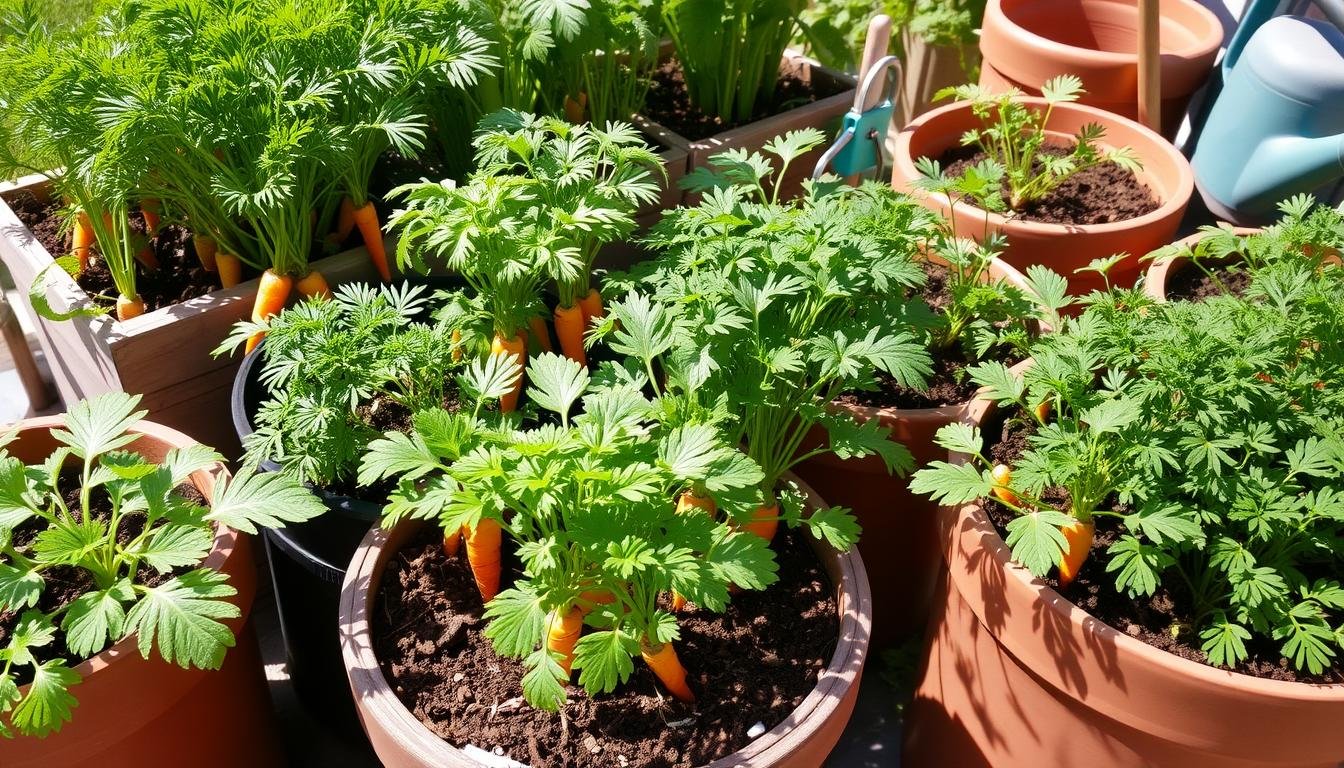
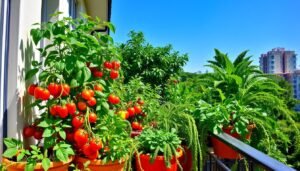
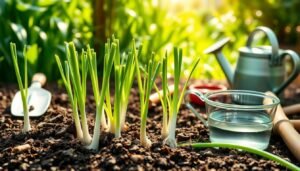
Pingback: how to plant full carrots that have sprouted
Pingback: how to grow carrots: Easy Steps for a Bountiful Harvest